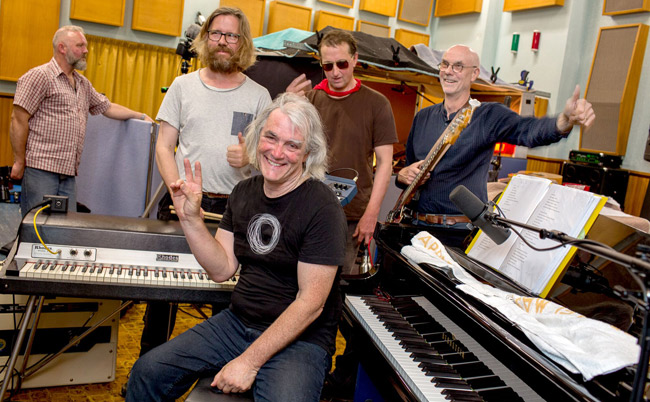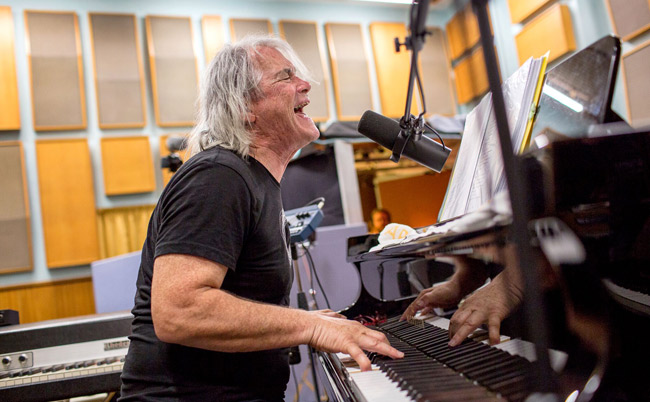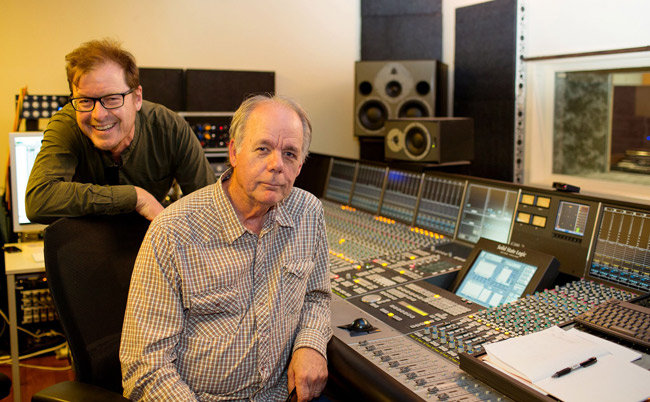Monday 17 December 2018 10:25am

Musicians gather for a three-day recording session organised as a tribute to the soon-to-be demolished Albany Street studio. Back row: Stephen Downes, Chris O’Connor, David Kilgour and John Dodd. Front: John Gibson. Photos: Sharron Bennett.
In a Beatles-like tribute to the University’s Albany Street recording studio, a group of Dunedin musicians, joined by some former Otago students, gathered at the studio from Friday to Sunday to record an album of 22 songs over the three days.
Before their rehearsal day on Thursday, none of the musicians had played together.
The Albany studio, built in 1967, is based on a BBC design and has often been compared to the Abbey Road studio in London where the Beatles recorded many of their famous hits, although the EMI studios at Abbey Road opened in 1931. And like the Beatles, all the musicians at the weekend’s recording were in the room together at one time.
As well as a celebration of the studio, the creation of the album forms part of a research project being done by the University’s Department of Music Senior Lecturer Dr John Egenes, who teaches studio production at the Albany studio.
“It’s about exploring the interactions between the musicians in the room. They know each other but they’d never played together,” Dr Egenes says. “It was about sending them on a serendipitous journey to discover what could be pulled off.”

John Gibson sings during the weekend's three-day recording session.
Convenor of the project, as well as the songwriter and principal artist, former Otago student John Gibson says the Albany Street studio is one of the few large studios, known as Temples of Sound, left in the world.
“We have incredible musicians down here. The idea was to celebrate the magic of musicians creating and playing together in the way that the Beatles worked,” he says. “It was a celebration of the power of music and musicians really, and what acoustic music really is about.”
He says that personally, it is also a way of giving back to the University. He studied music at Otago in the late 1970s.
“There’s a lot of giving back in this for me. The University gave me a place to dream, to love and get lost in, and happiness. Like all great education establishments it nurtured me to find myself.”
"We have incredible musicians down here. The idea was to celebrate the magic of musicians creating and playing together in the way that the Beatles worked."
The recording, which has been supported by the University’s 150th anniversary, was filmed by filmmaker Stephen Downes, with the hope of releasing a trailer that could help attract funding for a documentary, to be released during the 150th year in 2019.
Mr Gibson says they have plans to try to expand the album release process with an online conversation about music and performing, and may add single tracks to this before putting it out as an album, to keep the spirit of the project and the creative process going.
“I am very interested in a wider conversation about the role of music in the community, its power as knowledge and how we can rescue the industry and musicians from their current neglect in these challenging times – with the belief that a sense of music properly understood could indeed save the world,” he says.
Performers for the album included a number of well-known Dunedin musicians, including John Dodd, head of music at Logan Park High School on bass guitar, David Kilgour from The Clean and Craig Monk on violin and guitar.
Also performing was well-known saxophonist Stevie Rice, as well as Auckland drummer Chris O’Connor who has played with SJD and the Phoenix Foundation. Danny Buchanan was the engineer.
Mr Gibson says they hope to have some education content around the album.
“And one day I’d love to release it on vinyl, it feels right for the material.”
Next year, before the building is demolished, he also hopes to separately record a communal track with lots of Dunedin musicians and film it as a celebration of the studio.

Stephen Stedman (left) and John Egenes in front of the studio's Solid State Logic console, installed in 2010.
The studio at 180 Albany Street was built in 1967 for the New Zealand Broadcasting Corporation (NZBC). When the NZBC stopped using the building, the University leased it, before buying it in 2008.
In 2010 a state-of-the-art Solid State Logic console was installed and used for mixing recordings.
The demolition of the building at Albany Street studio is part of the University’s current Music, Theatre and Performing Arts project. This involves investing $26 million in constructing a new two-storey music recording studio building beside the Robertson Library in Union Street East while also refurbishing the Music Suite in the western end of the neighbouring University of Otago College of Education Music Block, along with the college’s nearby Teaching Wing and Tower Block.
Once those works have been completed, the remaining staff can move out of 180 Albany Street so the building will be demolished, which is expected to be in the first quarter of 2020.
The new Music, Theatre and Performing Arts facility has been chosen as one of this year’s five Annual Appeal fundraising initiatives for the University’s 150th anniversary year.
